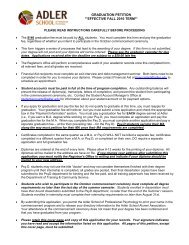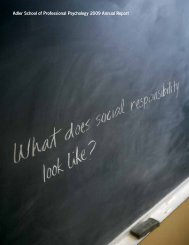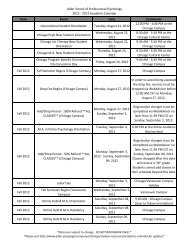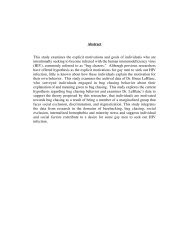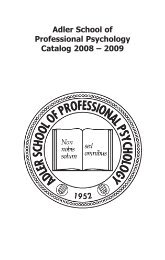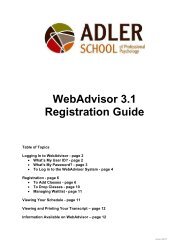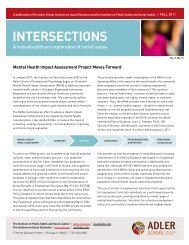Spring 2008 - Adler School of Professional Psychology
Spring 2008 - Adler School of Professional Psychology
Spring 2008 - Adler School of Professional Psychology
Create successful ePaper yourself
Turn your PDF publications into a flip-book with our unique Google optimized e-Paper software.
Individuals who are excluded from the digital world are similarly<br />
excluded from the so-called knowledge society. That is, they are denied<br />
access to myriad online information related to health care (e.g.,<br />
telemedicine), distance learning, job <strong>of</strong>ferings and a variety <strong>of</strong> social<br />
services. Unable to develop social networks, barred from acquiring social<br />
capital and relegated to living on the wrong side <strong>of</strong> the chasm created<br />
by the “divide,” people marginalized by digital illiteracy confront a<br />
plethora <strong>of</strong> exclusion-based problems – e.g., diminished career<br />
prospects, impaired life trajectories and socioeconomic immobility.<br />
Consequently, those who are adversely affected by the “Digital Divide”<br />
commonly live in environments marked by concentrated poverty and<br />
disproportionate minority disparities that are unknown to people living<br />
in the digitally-connected world.<br />
Today, principles <strong>of</strong> social justice require that we substantially increase<br />
efforts to close the social gap caused by the “Digital Divide”. Importantly,<br />
many socially responsible activists now believe that providing all<br />
residents <strong>of</strong> the United States with access to the digital world is an<br />
achievable goal.<br />
Social Exclusion<br />
and the Digital Divide<br />
“Digital divide” refers to the inequitable distribution <strong>of</strong> information<br />
technology precipitated by low socioeconomic status, spatial<br />
segregation, inadequate educational opportunities, poverty and a host<br />
<strong>of</strong> other socially constructed barriers. Coined in the mid-1990s, this term<br />
describes the absence <strong>of</strong> access to technological s<strong>of</strong>tware and<br />
hardware, as well as the lack <strong>of</strong> necessary education, training and<br />
experience required to use and derive benefit from all available<br />
information resources.<br />
Indeed, there are many potential opportunities for addressing the<br />
“Digital Divide” within our local communities. For example, currently<br />
there are groups in the Chicagoland area working diligently to bring the<br />
fruits <strong>of</strong> the information age into the lives <strong>of</strong> ordinary people. As Corinne<br />
Reynolds reports, Erie Neighborhood House is one such organization.<br />
Operating as a 501(c)(3) not-for-pr<strong>of</strong>it corporation and reaching more<br />
than 4,500 individuals annually, the Erie Neighborhood House empowers<br />
local residents to build better lives for themselves while strengthening<br />
the entire community,<br />
Closing the “Digital Divide” using local organizations, however, may not<br />
suffice when one considers the breadth <strong>of</strong> social exclusion flowing from<br />
technological inaccessibility. That’s the reason some people favor<br />
mandating inclusion <strong>of</strong> sophisticated digital resources – including<br />
broadband – in all new or refurbished public housing units. Taking such<br />
bold action could propel disadvantaged individuals toward realization<br />
<strong>of</strong> economic self-sufficiency and otherwise permit them to engage in<br />
mainstream society to even greater degrees.<br />
ERIE NEIGHBORHOOD HOUSE<br />
Corinne Reynolds<br />
For 138 years, Erie Neighborhood House has been working toward social justice for<br />
Chicago’s low-income and immigrant residents. Located in Chicago’s West Town,<br />
Humboldt Park, and Little Village neighborhoods, Erie House empowers Latino and<br />
diverse low-income communities to reach their fullest potential with a range <strong>of</strong><br />
award-winning educational programs for all ages. In its community technology<br />
program, Erie House partners with the Illinois Department <strong>of</strong> Commerce and<br />
Economic Opportunity (IDCEO) to bridge the digital divide among Chicago’s lowincome<br />
Latino population.<br />
Erie House has found technology to be a critical tool in addressing the issues <strong>of</strong><br />
poverty, low educational achievement, low employability and limited English<br />
pr<strong>of</strong>iciency that its community faces. In 1996, Erie House established one <strong>of</strong> the<br />
first community technology centers in Chicago. In 1999, Erie founded Technology<br />
Promoters, an innovative initiative that provides free information technology<br />
training to low-income adults while at the same time training those adults to<br />
become community technology educators to their peers. Since the program began,<br />
over 200 graduates have taught computer classes to over 1200 <strong>of</strong> their peers, and<br />
the Technology Promoters curriculum has been distributed to over 100 partner<br />
organizations throughout Chicago.<br />
For additional information regarding the work <strong>of</strong> the<br />
Erie Neighborhood House, contact: Ms. Alex Montgomery,<br />
Director <strong>of</strong> Development & Communications, Erie Neighborhood House,<br />
1701 West Superior Street, Chicago, IL 60622 (Tel. 312-432-2237)<br />
www.eriehouse.org.<br />
Bridging the Digital<br />
Divide at Erie House





